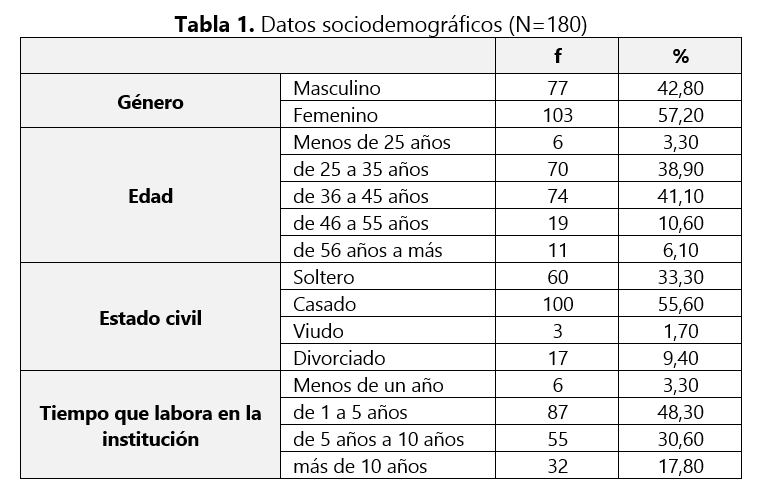Work climate and engagement in a health service provider entity in northeastern Peru, in times of COVID19
DOI:
https://doi.org/10.56926/unaaaciencia.v1i1.14Keywords:
work climate, work communication, engagement, vigorAbstract
The objective of this research was to determine the correlation between the work environment and engagement in the employees of Hospital II Tarapoto - EsSalud. In this study, the methodology for a basic research, quantitative approach, descriptive-correlational level and a non-experimental design was used. Likewise, the sample was non-probabilistic with a total of 180 participants. The technique was the survey and the instruments were subjected to Cronbach's alpha reliability: CL-SPC with a result of 0.962 and UWES-17 with a result of 0.926. The Kolmogorov-Smirnov normality test determined the use of the Rho Spearman coefficient. The results show that the work environment and engagement are regular (78.9% and 56.1%, respectively). In addition, there is a significant relationship between work environment and engagement with a p-value = 0.000 and the Rho Spearman = 0.566 **, which indicates that the relationship is moderate.
Downloads
References
Chiang Vega, M. M., Fuentealba Elgueta, I. I., & Nova Cabrera, R. A. (2017). Relación Entre Clima Organizacional y Engagement, en Dos Fundaciones Sociales, Sin Fines de Lucro, de la Región del Bio Bio. Ciencia & trabajo, 19(59), 105-112. https://doi.org/10.4067/S0718-24492017000200105
Coronel Chugden, J. W., Ayay Arista, G., & Milla Pino, M. E. (2020). Clima organizacional, satisfacción laboral y gestión administrativa en los órganos de apoyo de una universidad pública. Revista De La Universidad Del Zulia, 11(31). https://www.produccioncientificaluz.org/index.php/rluz/article/view/34042
Gutiérrez Lazo de la Vega, Z. (2020). Clima organizacional relacionado con la motivación del profesional de enfermería del Hospital Regional de Ica 2017-2018. Revista Enfermeria la Vanguardia, 8(1), 12-19. https://doi.org/10.35563/revan.v8i1.313
Hernández, C. E., & Carpio, N. (2019). Introducción a los tipos de muestreo. ALERTA. Revista Científica del Instituto Nacional de Salud, 2(1), 75-79. https://doi.org/10.5377/alerta.v2i1.7535
Hernández Sampieri, R., & Fernández Collado, Carlos Baptista Lucio, P. (2014). Metodología de la investigación (6.a ed.).
Jiménez, D. S., Méndez Celis, P. B., Arancibia Morales, D., & Cortes Tello, F. (2020). La importancia del clima y cultura organizacional para la atención en instituciones de salud. Universidad y Sociedad, 12(1). https://rus.ucf.edu.cu/index.php/rus/article/view/1751
Juarez García, A., Flores Jiménez, C. A., & Pelcastre Villafuerte, B. E. (2020). Factores psicosociales del trabajo y efectos psicológicos en comerciantes informales en Morelos, México: Una exploración preliminar. Salud UIS, 52(4). https://doi.org/10.18273/revsal.v52n4-2020007
López Ospina, J., & Meneghel, I. (2017). Clima Organizacional como antecedente del Engagement en una muestra de empresas colombianas. Modelo de Ecuaciones Estructurales. Revista Interamericana de Psicología Ocupacional, 35(1), 21-34. https://doi.org/10.21772/ripo.v35n1a02
Montoya Zuluaga, P. A., & Moreno Moreno, S. (2012). Relación entre Síndrome de Burnout, Estrategias de afrontamiento y Engagement. Psicología desde el Caribe, 29(1). https://rcientificas.uninorte.edu.co/index.php/psicologia/article/view/1940
Ocampo Bustos, R. M., Juárez-García, A., Arias Galicia, L. F., & Hindrichs, I. (2015). Factores psicosociales asociados a engagement en empleados de un restaurante de Morelos, México. LIBERABIT, 21(2). http://ojs3.revistaliberabit.com/index.php/Liberabit/article/view/262
Paco, R., & Matas, J. (2015). Clima organizacional y desempeño laboral docente en instituciones educativas de nivel primario y secundario. Apuntes de Ciencia & Sociedad, 05(02). https://doi.org/10.18259/acs.2015048
Pallant, J. (2020). SPSS Survival Manual (6.a ed.). Routledge. https://doi.org/10.4324/9781003117452
Palma Carrillo, S. P. (2004). Escala clima laboral CL-SPC (1.a ed.).
Peña-Viveros, R., Hernández-Hernández, D. M., Vélez-Moreno, A. M. L., García-Sandoval, M. G., Reyes-Tellez, M. A., & Ureña-Bogarin, E. L. (2015). Clima organizacional de equipos directivos y su relación con los resultados en la atención a la salud. Salud Pública de México, 57(6), 528. https://doi.org/10.21149/spm.v57i6.7642
Puitiza Lucano, C. M., Tejada Muñoz, S., Morales Rojas, E., Chávez Quintana, S., & Sánchez Santillan, T. (2020). Clima organizacional y desempeño laboral en trabajadores de la microred de salud Bagua Grande en Perú. Revista De La Universidad Del Zulia, 11(31). https://www.produccioncientificaluz.org/index.php/rluz/article/view/34044
Sanca, M. D. (2011). Tipos de investigación cientifica. Revista de Actualización Clínica Investiga, 9. https://doi.org/10.1016/S1696-2818(07)74162-8
Sandoval Caraveo, M. del C. (2004). Concepto y dimensiones del clima organizacional. Revista Hitos de Ciencias Económico Administrativas, 10(27). https://revistas.ujat.mx/index.php/hitos/article/view/4402
Schaufeli, W. B., & Bakker, A. B. (2011). UWES–Utrecht Work Engagement Scale: Manual. Occupational Health Psychology Unit, Utrecht University. https://www.wilmarschaufeli.nl/publications/Schaufeli/Test Manuals/Test_manual_UWES_Espanol.pdf
Schaufeli, Wilmar B., Martínez, I. M., Pinto, A. M., Salanova, M., & Bakker, A. B. (2002). Burnout and Engagement in University Students. Journal of Cross-Cultural Psychology, 33(5), 464-481. https://doi.org/10.1177/0022022102033005003
Sharma, R., Webster, P., & Bhattacharyya, S. (2014). Factors affecting the performance of community health workers in India: a multi-stakeholder perspective. Global Health Action, 7(1), 25352. https://doi.org/10.3402/gha.v7.25352
Torres Pacheco, E., & Zegarra Ugarte, S. J. (2015). Clima organizacional y desempeño laboral en las instituciones educativas bolivarianas de la ciudad Puno -2014 – Perú. COMUNI@CCIÓN: Revista de Investigación en Comunicación y Desarrollo, 6(2), 5-14. https://comunicacionunap.com/index.php/rev/article/view/66
Trógolo, M. A., Pereyra, A. P., & Sponton, C. (2013). Impacto de Diferentes Estilos de Liderazgo Sobre el Engagement y Burnout: Evidencia en una Muestra de Trabajadores Argentinos. Ciencia & trabajo, 15(48), 152-157. https://doi.org/10.4067/S0718-24492013000300008

Published
How to Cite
Issue
Section
License
Copyright (c) 2022 Carmen Joesy Trigozo-Pezo, Marisa Fiorella Sánchez-Rodríguez, David Troya-Palomino, Jose Joel Cruz-Tarrillo

This work is licensed under a Creative Commons Attribution 4.0 International License.
The authors retain their rights:
a. The authors retain their trademark and patent rights, as well as any process or procedure described in the article.
b. The authors retain the right to share, copy, distribute, execute and publicly communicate the article published in the scientific journal UNAAACIENCIA-PERÚ (for example, place it in an institutional repository or publish it in a book), with an acknowledgment of its initial publication in UNAAACIENCIA-PERU.
c. Authors retain the right to make a subsequent publication of their work, to use the article or any part of it (for example: a compilation of their works, notes for conferences, thesis, or for a book), provided that they indicate the source. of publication (authors of the work, magazine, volume, number and date).







